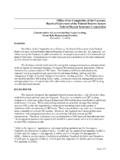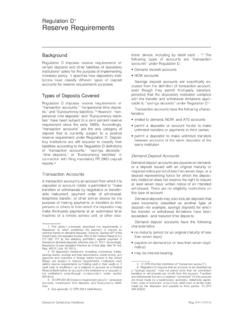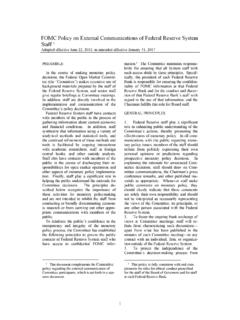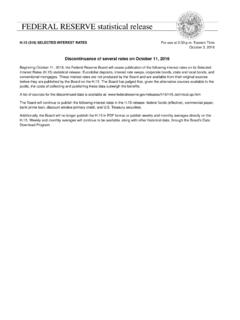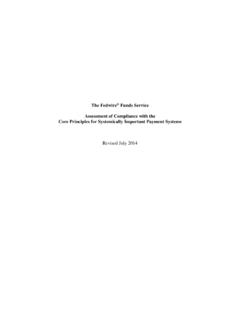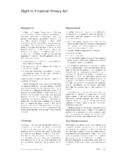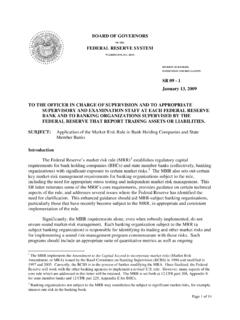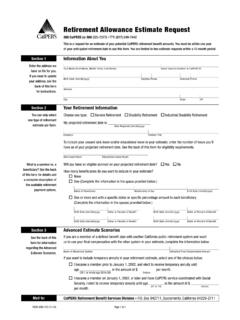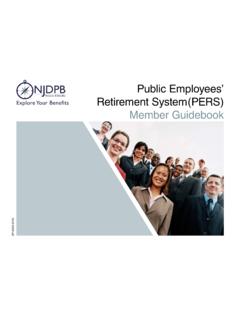Transcription of Transcript of Chair Powell's Press Conference -- December ...
1 December 15, 2021 Chair Powell s Press Conference FINAL Page 1 of 31 Transcript of Chair Powell s Press Conference December 15, 2021 Chair POWELL. Good afternoon. At the Federal Reserve, we are strongly committed to achieving the monetary policy goals that Congress has given us: maximum employment and price stability. Today, in support of these goals, the Federal Open Market Committee kept interest rates near zero and updated its assessment of the progress that the economy has made toward the criteria specified in the Committee s forward guidance for interest rates. In addition, in light of the strengthening labor market and elevated inflation pressures, we decided to speed up the reductions in our asset purchases.
2 As I will explain, economic developments and changes in the outlook warrant this evolution of monetary policy, which will continue to provide appropriate support for the economy. Economic activity is on track to expand at a robust pace this year, reflecting progress on vaccinations and the reopening of the economy. Aggregate demand remains very strong, buoyed by fiscal and monetary policy support and the healthy financial positions of households and businesses. The rise in COVID cases in recent weeks, along with the emergence of the Omicron variant, pose[s] risks to the outlook. Notwithstanding the effects of the virus and supply constraints, FOMC participants continue to foresee rapid growth.
3 As shown in our Summary of Economic Projections (SEP), the median projection for real GDP growth stands at percent this year and 4 percent next year. Amid improving labor market conditions and very strong demand for workers, the economy has been making rapid progress toward maximum employment. Job gains have been solid in recent months, averaging 378,000 per month over the last three months. The unemployment rate has declined substantially falling 6/10 of a percentage point since our last December 15, 2021 Chair Powell s Press Conference FINAL Page 2 of 31 meeting and reaching percent in November.
4 The recent improvements in labor market conditions have narrowed the differences in employment across groups, especially for workers at the lower end of the wage distribution, as well as for African Americans and Hispanics. Labor force participation showed a welcome rise in November but remains subdued, in part reflecting the aging of the population and retirements. In addition, some who otherwise would be seeking work report that they are out of the labor force because of factors related to the pandemic, including caregiving needs and ongoing concerns about the virus. At the same time, employers are having difficulties filling job openings, and wages are rising at their fastest pace in many years.
5 How long the labor shortages will persist is unclear, particularly if additional waves of the virus occur. Looking ahead, FOMC participants project the labor market to continue to improve, with the median projection for the unemployment rate declining to percent by the end of the year. Compared with the projections made in September, participants have revised their unemployment rate projections noticeably lower for this year and next. Supply and demand imbalances related to the pandemic and [to] the reopening of the economy have continued to contribute to elevated levels of inflation. In particular, bottlenecks and supply constraints are limiting how quickly production can respond to higher demand in the near term.
6 These problems have been larger and longer lasting than anticipated, exacerbated by waves of the virus. As a result, overall inflation is running well above our 2 percent longer-run goal and will likely continue to do so well into next year. While the drivers of higher inflation have been predominantly connected to the dislocations caused by the pandemic, price increases have now spread to a broader range of goods and services. Wages have also risen briskly, but, thus far, wage growth has not been a major contributor to the elevated levels of inflation. We are attentive to the risks that persistent real wage growth in excess of productivity [growth] could put December 15, 2021 Chair Powell s Press Conference FINAL Page 3 of 31 upward pressure on inflation.
7 Like most forecasters, we continue to expect inflation to decline to levels closer to our 2 percent longer-run goal by the end of next year. The median inflation projection of FOMC participants falls from percent this year to percent next year; this trajectory is notably higher than projected in September. We understand that high inflation imposes significant hardship, especially on those least able to meet the higher costs of essentials like food, housing, and transportation. We are committed to our price-stability goal. We will use our tools both to support the economy and a strong labor market and to prevent higher inflation from becoming entrenched.
8 We will be watching carefully to see whether the economy is evolving in line with expectations. The Fed s monetary policy actions have been guided by our mandate to promote maximum employment and stable prices for the American people. In support of these goals, the Committee reaffirmed the 0 to percent target range for the federal funds rate. We also updated our assessment of the progress the economy has made toward the criteria specified in our forward guidance for the federal funds rate. With inflation having exceeded 2 percent for some time, the Committee expects it will be appropriate to maintain this target range until labor market conditions have reached levels consistent with the Committee s assessments of maximum employment.
9 All FOMC participants forecast that this remaining test will be met next year. The median projection for the appropriate level of the federal funds rate is percent at the end of 2022, about percentage point higher than projected in September. Participants expect a gradual pace of policy firming, with the level of the federal funds rate generally near estimates of its longer-run level by the end of 2024. Of course, these projections do not represent a December 15, 2021 Chair Powell s Press Conference FINAL Page 4 of 31 Committee decision or plan, and no one knows with any certainty where the economy will be a year or more from now.
10 At today s meeting, the Committee also decided to double the pace of reductions in its asset purchases. Beginning in mid-January, we will reduce the monthly pace of our net asset purchases by $20 billion for Treasury securities and $10 billion for agency mortgage-backed securities. If the economy evolves broadly as expected, similar reductions in the pace of net asset purchases will likely be appropriate each month, implying that increases in our securities holdings would cease by mid-March a few months sooner than we anticipated in early November. We are phasing out our purchases more rapidly because, with elevated inflation pressures and a rapidly strengthening labor market, the economy no longer needs increasing amounts of policy support.
